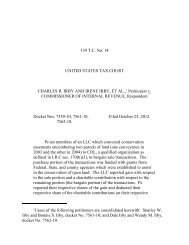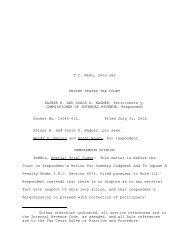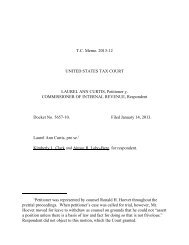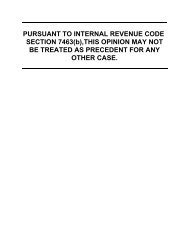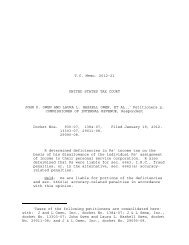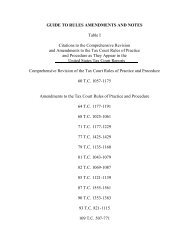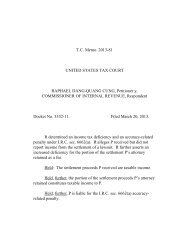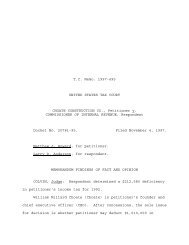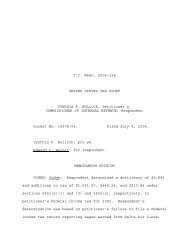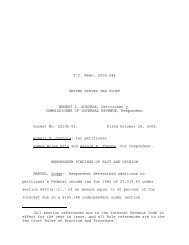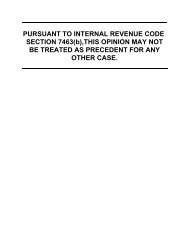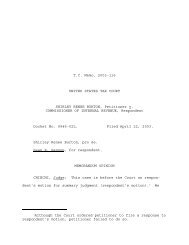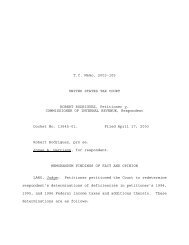T.C. Memo. 2007-134 UNITED STATES TAX ... - U.S. Tax Court
T.C. Memo. 2007-134 UNITED STATES TAX ... - U.S. Tax Court
T.C. Memo. 2007-134 UNITED STATES TAX ... - U.S. Tax Court
You also want an ePaper? Increase the reach of your titles
YUMPU automatically turns print PDFs into web optimized ePapers that Google loves.
T.C. <strong>Memo</strong>. <strong>2007</strong>-<strong>134</strong><strong>UNITED</strong> <strong>STATES</strong> <strong>TAX</strong> COURTBARRY E. MOORE AND DEBORAH E. MOORE, Petitioners v.COMMISSIONER OF INTERNAL REVENUE, RespondentDocket No. 11002-03. Filed May 30, <strong>2007</strong>.In 1988, Ps, Georgia residents, purchased a secondhome (vacation home 1), also in Georgia, which thefamily used on weekends from mid-April to Labor Day forrecreational purposes. After Ps changed theirprincipal residence in 1995 or 1996, the lengthenedcommute to vacation home 1 made its continued useimpractical, and, in 1999, they agreed to purchaseanother vacation home (vacation home 2) closer to theirprincipal residence. In 2000, Ps disposed of vacationhome 1 and acquired vacation home 2 pursuant to aseries of transactions intended to qualify as a taxfree,like-kind exchange of those properties under sec.1031, I.R.C. Prompted by the need for liquidityincident to their then-pending divorce, Ps were holdingvacation home 2 for sale at the time of trial. Ps andtheir children used both vacation homes exclusively forrecreational purposes, and Ps never rented or offeredto rent either vacation home to third parties. One ofPs’ motives in acquiring and holding each vacation home
- 3 -PW’s 2000 sale of her 12-percent LLC membershipinterest.Vivian D. Hoard and Patti M. Richards, for petitioners.Michael L. Scheier and Jennifer J. Morales, for affectedperson United Surgical Partners International, Inc.Brenda M. Fitzgerald, for respondent.MEMORANDUM FINDINGS OF FACT AND OPINIONHALPERN, Judge: By notice of deficiency dated April 10,2003 (the notice), respondent determined deficiencies inpetitioners’ Federal income tax as follows:YearDeficiency1999 $96,9252000 78,578By the petition, petitioners assign error to respondent’sdeficiency determination. The parties have resolved certainissues. 1 The remaining issues for decision are whether (1)petitioners’ purported exchange of vacation properties qualifiesas a tax-free “like-kind” exchange of properties under section1Those issues are (1) issues settled or conceded pursuantto the parties’ stipulation of settled issues executed on May 19,2004, and (2) issues that petitioners failed to pursue on brief,which we treat as having been abandoned. See Nicklaus v.Commissioner, 117 T.C. 117, 120 n.4 (2001). The issues thatpetitioners failed to pursue are (1) whether petitioners arerequired to include in income for 1999 $1,701 of interest and (2)whether petitioner Barry E. Moore is entitled to relief from taxliability for either 1999 or 2000 as an innocent spouse.
- 4 -1031 2 (the section 1031 issue), (2) petitioner Deborah E. Moore(Ms. Moore) increased her membership interest in The SurgeryCenter of Georgia, LLC (the LLC) before the years in issue (1999and 2000), as alleged by respondent, or in July 2000, as allegedby petitioners (the membership interest acquisition issue), and(3) petitioners are entitled to report Ms. Moore’s gain on thesale of her membership interest in the LLC under the installmentmethod, in accordance with section 453 (the installment methodreporting issue). 3The notice contains certain other adjustments that arepurely computational. Their resolution solely depends upon ourresolution of the issues remaining in dispute.2Unless otherwise indicated, all section references are tothe Internal Revenue Code in effect for the years in issue, andall Rule references are to the <strong>Tax</strong> <strong>Court</strong> Rules of Practice andProcedure.3The parties also disagree regarding the application ofsec. 7491(a) to this case. If applicable to a factual issue,sec. 7491(a) would cause the burden of proof on that issue toshift from petitioners to respondent. See Rule 142(a). We neednot decide whether sec. 7491(a) applies herein because we resolveall factual issues upon a preponderance of the evidence.Therefore, resolution of the issues in this case does not dependupon which party bears the burden of proof. See Estate ofBongard v. Commissioner, 124 T.C. 95, 111 (2005); see alsoBlodgett v. Commissioner, 394 F.3d 1030, 1039 (8th Cir. 2005),affg. T.C. <strong>Memo</strong>. 2003-212; FRGC Inv., LLC v. Commissioner, 89Fed. Appx. 656 (9th Cir. 2004), affg. T.C. <strong>Memo</strong>. 2002-276;Brookfield Wire Co. v. Commissioner, 667 F.2d 551, 553 n.2 (1stCir. 1981), affg. T.C. <strong>Memo</strong>. 1980-321.
- 6 -brief pursuant to Rule 151. Under the circumstances, we find itinappropriate to disregard or strike respondent’s opening (orreply) brief, and we decline to do so.FINDINGS OF FACTSome facts have been stipulated and are so found. Thestipulation of facts, with attached exhibits, is incorporatedherein by this reference.At the time the petition was filed, petitioner Barry E.Moore (Mr. Moore) resided in Elberton, Georgia, and Ms. Mooreresided in Marietta, Georgia.The Section 1031 IssueBackgroundOn April 15, 1988, petitioners purchased two contiguousparcels of lakefront real property, along with a mobile homelocated on one of those parcels, on Clark Hill Lake in LincolnCounty, Georgia (the Clark Hill property). On December 3, 1999,petitioners entered into a purchase and sale agreement whereinthey agreed to purchase improved lakefront property in ForsythCounty, Georgia (the Lake Lanier property). Thereafter, during2000, petitioners were involved in a series of transactionswhereby they purported to (1) assign a 25-percent interest in thepurchase and sale agreement to an escrow agent, (2) join with theescrow agent in purchasing the Lake Lanier property (75 percentacquired by petitioners, 25 percent by the escrow agent), and (3)
- 7 -after buyers for the Clark Hill property had been found, throughan intermediary, exchange the Clark Hill property for the escrowagent’s 25-percent interest in the Lake Lanier property in atransaction intended to qualify as a deferred like-kind exchangesatisfying the requirements of section 1031(a)(3) and section1.1031(k)-1, Income <strong>Tax</strong> Regs. Respondent denies the authenticityof much of petitioners’ supporting documentation and alleges that(1) the escrow agent was, in substance, acting as petitioners’agent in acquiring a 25-percent interest in the Lake Lanierproperty so that petitioners already owned that property beforethe purported like-kind exchange; i.e., there was no “exchange”of like-kind properties, and (2) petitioners otherwise failed tosatisfy the requirements of section 1031(a)(3) and theregulations thereunder for a deferred like-kind exchange.In order for petitioners to prevail on the section 1031issue, the evidence must show that (1) the Clark Hill and LakeLanier properties were of like kind (a matter not in dispute),(2) petitioners held both properties for investment, 4 and (3)they disposed of the former and acquired the latter in a mannerthat satisfied the requirements of section 1031(a)(3) and theregulations thereunder for a deferred like-kind exchange.4Petitioners do not claim that either property satisfiedthe alternative definition of qualified like-kind property:“property held for productive use in a trade or business”. Sec.1031(a)(1).
- 8 -Because we find that petitioners held neither property forinvestment, we make no findings of fact relating to thesufficiency of petitioners’ attempt to satisfy the otherrequirements for a deferred like-kind exchange. 5Petitioners’ Purchase and Use of the PropertiesThe Clark Hill PropertyPetitioners’ decision to purchase the Clark Hill propertywas motivated, in part, by their familiarity with the area, bothhaving grown up in the vicinity of Clark Hill Lake. In addition,both their families owned property on or near Clark Hill, and Mr.Moore’s father advised them that property on Clark Hill Lake hadappreciated and would continue to appreciate. Petitioners’decision to invest in real estate rather than in intangibles,such as stocks or bonds, was influenced by a prior bad experiencewith a financial adviser who had stolen their money.When in 1988 they purchased the Clark Hill property,petitioners’ primary residence was in Norcross, Georgia, anapproximately 3-hour drive from the Clark Hill property. In 1995or 1996, petitioners changed their primary residence to Marietta,Georgia. The drive from the Marietta residence to the Clark Hillproperty normally took between 5 and 6 hours.5As a result, we need not rule on respondent’s objectionsto various documents petitioners offered.
- 9 -Beginning in late March of each year during which they ownedthe Clark Hill property, Mr. Moore would spend a couple ofweekends there getting it ready for the summer months. Then,beginning in mid to late April, petitioners’ family would visitthe property two and, sometimes, three weekends a month untilLabor Day, when Mr. Moore closed the property for the winter.Between Labor Day and the following March, Mr. Moore wouldoccasionally visit the property to rake leaves and perform othercaretaker functions.The mobile home located on the property was a double-widemobile home. During their tenure, petitioners built a deckaround it, built a screened-in porch on top of a portion of thedeck, and installed a satellite television receiver, a newtelevision, and a VHS recorder. They also replaced the roof andrepainted the home two or three times. They installed a newwasher and dryer and replaced some of the furniture (bedroomseats and beds) that had come with the home. They kept a pontoonboat on Clark Hill Lake and improved the dock they had in thelake to conform to the U.S. Army Corps of Engineers electricalrequirements. During their summer stays at the Clark Hillproperty, petitioners and their children used the property forvarious recreational purposes, including relaxing on the dock,boating, and fishing.
- 10 -Until they decided to acquire the Lake Lanier property inlate 1999, petitioners had never advertised the Clark Hillproperty for sale although they had been offered money for it.Also, petitioners never rented or attempted to rent the propertyto others.On their 1996-99 Federal income tax returns, petitionerslisted deductions for “home mortgage interest”. They did notlist on those returns any deduction for investment interest, nordid they deduct any maintenance or other expenses associated withthe Clark Hill property.The Lake Lanier PropertyReasons for PurchaseAfter petitioners changed their principal residence fromNorcross to Marietta, Georgia, the length of the drive to theClark Hill property coupled with their children’s increasedweekend activities (in particular, their son’s participation inweekend sports) made it inconvenient for the family to spendweekends at the property. As a result, they used that propertyless frequently and, during the 2 years before their dispositionof it, they may have visited the property a total of three times.During that period, it became a chore for Mr. Moore just tomaintain the property, with the result that it became rundown andhad to be either renovated or disposed of.
- 11 -Beginning in late 1997 or early 1998, the foregoing problemsassociated with the Clark Hill property caused petitioners toinvestigate properties on Lake Lanier, which is much closer towhat was at the time petitioners’ Marietta, Georgia, residence.Petitioners felt that a house on Lake Lanier would be of more useto them than the Clark Hill property. Petitioners also believedthat property on Lake Lanier would appreciate more rapidly thanthe Clark Hill property because it was closer to the metropolitanAtlanta area. Petitioners acquired the Lake Lanier property inJanuary 2000.Use of the PropertyThe Lake Lanier property consisted of a greater than 1.2-acre tract of land, the largest double slip dock allowable on thelake (complete with two lifts), and a house that had fivescreened-in porches overlooking the lake, a full party deck, acovered veranda, a great room with a stone fireplace, fivebedrooms, and 4-1/2 bathrooms. At the time of purchase, thehouse was partially furnished, and, after purchase, petitionerscompleted the furnishing themselves. They installed a satelliteTV system and a VHS recorder, and, before their second summer atthe property, they purchased a motorboat with room for six toeight passengers.Petitioners and their children engaged in essentially thesame activities at the Lake Lanier property as they had at the
- 12 -Clark Hill property. They visited the property two weekends permonth beginning in mid-March (depending on the weather) andending around Labor Day. In addition, the family might visit theproperty once or twice each winter, and Mr. Moore and his sonwould fish off the dock one Saturday night each month during thefall. During the summer months, petitioners occasionallyentertained visitors at the house. Mr. Moore’s maintenanceactivities at the Lake Lanier property were similar to, but lessfrequent than, his maintenance activities at the Clark Hillproperty.The mortgage lender in connection with petitioners’ purchaseof the Lake Lanier property was SouthTrust Bank, N.A. (SouthTrustBank). 6 On their 2000-02 Federal income tax returns, petitionersclaimed deductions for home mortgage and investment interest paidto SouthTrust Bank as follows:Year Home Mortgage Interest Investment Interest2000 $36,219 $5,6472001 42,437 1,9942002 45,766 --As in the case of the Clark Hill property, petitioners didnot list on their 2000-02 returns any deductions for maintenanceor other expenses associated with the Lake Lanier property.6In its “Credit Offering Report” assessing the risk ofvarious loans to Ms. Moore, including the loan to purchase theLake Lanier property, that property, which was to serve assecurity for those loans, is consistently referred to as a“second residence”.
- 13 -Also, as in the case of the Clark Hill property, petitionersnever rented or attempted to rent the Lake Lanier property, andthey never offered it for sale until forced to do so by the needfor liquidity in connection with the division of their assetsincident to their divorce. Both the sale and the divorce werestill pending at the time of the trial.The Membership Interest Acquisition IssueThe LLC Operating AgreementThe LLC was organized in the State of Georgia on April 19,1995, and, as of that date, the “Operating Agreement of TheSurgery Center of Georgia” (the LLC operating agreement or theagreement) became effective. Pursuant to the agreement, theinitial members of the LLC and their initial membership interestswere as follows:Member Percent InterestLaser Centers of America, Inc. 45Stephen N. Joffe, M.D. 35Barry McKernan, M.D. 10Hugh McLeod, M.D. 8Deborah Moore 2At that time, Dr. Joffe was the CEO and sole shareholder of LaserCenters of America, Inc., which was designated the manager of theLLC. 77On a day-to-day operational basis, however, Ms. Mooremanaged the LLC.
- 14 -Article 8 of the LLC operating agreement governs“Allocations and Distributions”. Section 8.5, entitled “InterimDistributions”, provides in pertinent part as follows:To the extent * * * [cash in excess of current andanticipated needs] exists, the Members * * * may makeDistributions to the Members in accordance with theirMembership Interests. Such distributions shall be incash or Property (which need not be distributedproportionately) or partly in both, as determined bythe Manager.Article 10 of the agreement is entitled “Disposition ofMembership Interests”. Section 10.1 provides: “No MembershipInterest of the * * * [LLC] shall be Disposed, except ashereinafter provided in this Article 10.” Section 10.2.1,governing voluntary dispositions of membership interests,provides in pertinent part: “Any Member who desires voluntarilyto Dispose of the Membership Interest * * * owned by him in the* * * [LLC] shall give the Manager * * * written notice of hisintent and the terms of such proposed Disposition.” Section 10.3gives the LLC an overall 90-day right of first refusal topurchase or to designate a purchaser for the selling member’sinterest at a designated purchase price. Section 10.5 providesthat the closing of a sale of a membership interest must occur nolater [earlier?] than 90 days after the giving of written noticeof the sale required in section 10.2. Section 10.7 states: “Anyattempted Disposition of a Membership Interest, or any part
- 15 -thereof, not in compliance with * * * [article 10] is null andvoid ab initio.”Dr. Joffe’s 1995 Purchases of Additional Interests in theLLCOn September 28, 1995, Laser Centers of America, Inc., soldits 45-percent membership interest in the LLC to Dr. Joffe, and,on December 31, 1995, Dr. McLeod sold his 8-percent membershipinterest in the LLC to him. As a result, as of December 31,1995, Dr. Joffe owned 88 percent, Dr. McKernan owned 10 percent,and Ms. Moore owned 2 percent of the LLC.The Moore Letter; the Joffe <strong>Memo</strong>randumIn a handwritten letter dated July 1, 1997, to James P.Kelly (Mr. Kelly), counsel to the LLC during 1996-98, Ms. Moorelisted percentage distributions, including an 8-percent share forherself, “should * * * [the LLC] be sold or distributions bemade.” In that letter (the Moore letter), Ms. Moore furthernoted: “Deborah Moore has 2% originally already. Also, theagreement for the above percentages in no way interferes with theoriginal LLC percentages.” 88In substantial part, the Moore letter states:James P. Kelly200 Galleria PkwySuite 1510Atlanta, Ga 30339July 1, 1997(continued...)
- 16 -Sometime between July 1 and late December 1997, Dr. Joffeexecuted a handwritten, undated memorandum (the Joffe memorandum)to Ms. Moore, in which he states: “This is to confirm thatDebbie Moore will receive 10% (Ten Percent) of the net proceedsof the sale of * * * [the LLC].”The Kelly CorrespondenceDuring 1997, Mr. Kelly sent three letters (the Kellycorrespondence) to Ms. Moore in her capacity as the de factomanager of the LLC.In the first letter, dated October 17, 1997, Mr. Kellyadvised Ms. Moore that the LLC could “lawfully issue 6% of itsstock to you under the safe harbor for reasonable compensation toJim:8(...continued)I spoke with Dr. Joffe and here are the % distributions forthe Surgery Center of Georgia, LLC should the center be sold ordistributions be made. These are % of net profit.J. Barry McKernan -- 10%J.K. Champion -- 3%Robert S. Cowles -- 3%Deborah Moore -- 8%Ronald Van Tuyl -- 1%William S. Armstrong -- 2%Rick Hawkins -- 1%J. Barry McKernan has originally 10% already in the SurgeryCenter of Ga and Deborah Moore has 2% originally already. Alsothe agreement for the above percentages in no way interferes withthe original LLC percentages. Call for questions.Thanks,Deborah Moore
- 17 -employees.” The letter also describes the formal requirementsneeded to effect such an issuance of shares.The other two letters, both dated October 28, 1997, concernthe potential application of Medicare Antikickback laws toproposed physician acquisitions of stock in the LLC. In one ofthose letters, Mr. Kelly states his understanding that the LLC“currently is owned by Dr. Joffe (88%) * * * Dr. McKernan (10%)and * * * [Ms. Moore] (2%)”.The SouthTrust Bank Credit Offering Report and the $50,000Revolving NoteIn connection with a $50,000 loan to the LLC, evidenced by a$50,000 “revolving note” dated March 29, 1999, SouthTrust Bankprepared a “Credit Offering Report” (the SouthTrust Bank creditreport), which states: “The [LLC] was started, according to thetax return, on 5/1/95. During 1995, two members of the LLC soldtheir interests to Dr. Joffe who now owns 88%.” That portion ofthe SouthTrust Bank credit report is date-stamped “Dec-01-98”.In another portion of the SouthTrust Bank credit report, entitled“Collateral”, the word “Unsecured” appears. The word “Unsecured”is also typed on the revolving note in the section of theprinted form dealing with security agreements.The LLC ReturnsThe initial short year return, Form 1065, U.S. PartnershipReturn of Income, filed by the LLC for 1995 reflects the 1995sales by Laser Centers of America, Inc., of its 45-percent
- 18 -ownership interest and by Dr. McLeod of his 8-percent ownershipinterest in the LLC to Dr. Joffe. The sales are reflected infootnotes to the Schedules K-1, Partner’s Share of IncomeCredits, Deductions, etc., prepared for Drs. Joffe and McLeod andfor Laser Centers of America, Inc.The returns filed by the LLC for 1996-99 include SchedulesK-1 for Drs. Joffe and McKernan and for Ms. Moore (collectively,the LLC members), which reflect percentage profit and losssharing and capital ownership interests for them of 88, 10, and 2percent, respectively. The LLC’s final return for its short yearending July 31, 2000, reflects those same percentage interestsfor the LLC members at the beginning of the year, and a zeropercentinterest for each at yearend. 9The LLC’s 1996 and 1997 returns reflect no distributions tothe LLC members. The 1998-2000 LLC returns reflect distributionsto the LLC members in the following amounts and percentages oftotal distributions:1998 1999 2000Member Amount % of Total Amount % of Total Amount % of TotalDr. Joffe $40,538 67.86 $268,510 63.91 $978,466 68Dr. McKernan 12,000 20.08 96,979 23.08 287,785 20Ms. Moore 7,200 12.05 54,642 13.01 172,671 12Sale of the LLC Membership InterestsOn or about November 30, 1999, the LLC, the LLC members, andSurgicoe Corp. (Surgicoe) entered into a “Membership Interest9As discussed infra, the LLC members sold their interestsin the LLC effective July 28, 2000.
- 19 -Purchase Agreement” (the Surgicoe purchase agreement) pursuant towhich the LLC members agreed to sell their membership interestsin the LLC to Surgicoe for a total of $9,988,352, subject tocertain adjustments at closing. After those adjustments, thetotal purchase price was reduced to $9,490,051. The Surgicoepurchase agreement provides that “[t]he Purchase Price shall beallocated as set forth in Schedule 2.2.4.” The record containstwo such schedules. The first, presumably attached to theagreement, provides: “Consideration to be allocated amongSellers as provided in a closing statement to be executed bySellers at Closing.” The second, presumably executed sometimebetween the dates of the Surgicoe purchase agreement and theclosing, allocates the total purchase price among the LLC memberson the following percentage basis: 68 percent to Dr. Joffe, 20percent to Dr. McKernan, and 12 percent to Ms. Moore. Thedistribution of the final, adjusted purchase price was asfollows:Member Amount % of TotalDr. Joffe $6,453,234.68 68Dr. McKernan 1,898,010.20 20Ms. Moore 1,138,806.12 12Surgicoe’s purchase of Ms. Moore’s interest in the LLCconsisted of Ms. Moore’s receipt from Surgicoe of $661,774.01 incash, LLC debt relief apportioned to Ms. Moore of $316,206.24,and a promissory note dated July 28, 2000, in the sum of
- 20 -$160,825.87. Also, on that date, Ms. Moore executed (1) a“Certificate of Limited Liability Company Interest in the SurgeryCenter of Georgia, LLC”, in which she certifies to her ownershipof a “12% limited liability company interest * * * in [the LLC],”and (2) an “Irrevocable Member Interest Power” pursuant to whichshe states that she “does hereby sell * * * to [Surgicoe] a 12%interest as a member in [the LLC]” and appoints a named attorneyto transfer that interest on the LLC’s books.Assignment and Assumption AgreementIn 2000, in connection with, and sometime before, the July28, 2000, closing of the sale of the LLC membership interests toSurgicoe, Drs. Joffe and McKernan and Ms. Moore executed an“Assignment and Assumption Agreement * * * made and entered intoand effective as of the 1st day of January, 1997” (the assignmentand assumption agreement or, sometimes, just the agreement),whereby Dr. Joffe, “in consideration of the continued services of* * * [Dr. McKernan and Ms. Moore] and other good and valuableconsideration”, transferred a 10-percent membership interest inthe LLC to Dr. McKernan and a 10-percent membership interest inthe LLC to Ms. Moore. The last sentence of the agreement, justbefore the signatures of Drs. Joffe and McKernan and Ms. Moore,reads: “IN WITNESS WHEREOF, the parties have executed thisAgreement under seal to be effective as of the date [January 1,1997] first above written.” The agreement states that it is “a
- 21 -Georgia contract and shall be governed by and construed inaccordance with Georgia law.”Dr. Joffe, on behalf of himself as manager of the LLC and onbehalf of the LLC, executed a “Waiver of Notice and Right toPurchase” (which is attached to the assignment and assumptionagreement) whereby he specifically waived (1) the right toreceive notice pursuant to section 10.2.1 of the LLC operatingagreement of his membership interest dispositions and (2) theLLC’s rights, pursuant to section 10.3 of the LLC operatingagreement, either to purchase Dr. Joffe’s 10-percent membershipinterests transferred to Dr. McKernan and Ms. Moore or toidentify another purchaser thereof.The Installment Method Reporting IssueAs noted supra, part of the consideration Ms. Moore receivedfor the sale of a 12-percent interest in the LLC to Surgicoeconsisted of a promissory note in the sum of $160,825.87. Thatnote provided for 60 consecutive monthly payments of combinedprincipal and interest of $3,358.03, beginning September 1, 2000,and ending August 1, 2005. On their 2000 return, Schedule D,Capital Gains and Losses, petitioners reported as long-termcapital gain $631,590 from the July 28, 2000, sale of“partnership interest” and “note payments” in the sum of $16,790.
- 22 -OPINIONI. The Section 1031 IssueA. AnalysisAs noted supra, the issue before us is whether petitionersheld the Clark Hill and Lake Lanier properties “for investment”.That depends on their intent or purpose in holding theproperties, determined as of the time of the exchange. E.g.,Bolker v. Commissioner, 81 T.C. 782, 804 (1983), affd. 760 F.2d1039 (9th Cir. 1985).Petitioners point to their interest in the appreciationpotential of the Clark Hill and Lake Lanier properties, bothbefore and after acquisition, and argue: “If investment intentis one motive for holding * * * property, it is held forinvestment for purposes of Section 1031.” Petitioners’ argument,if carried to its logical extreme, is that the existence of anyinvestment motive in holding a personal residence, no matter howminor a factor in the overall decision to acquire and hold (orsimply to hold) the property before its inclusion in an exchangeof properties, will render it “property * * * held forinvestment” with any gain on the exchange eligible fornonrecognition treatment under section 1031. Petitioners aremistaken. It is a taxpayer’s primary purpose in holding theproperties that counts. Montgomery v. Commissioner, T.C. <strong>Memo</strong>.1997-279 (“section 1031 requires that both the property
- 23 -transferred and the property received in a like-kind exchange beheld primarily for productive use in a trade or business, or forinvestment.”), affd. in part and revd. in part on another issuewithout published opinion 300 F.3d 866 (10th Cir. 1999). Indeed,in Starker v. United States, 602 F.2d <strong>134</strong>1, 1350-1351 (9th Cir.1979), the U.S. <strong>Court</strong> of Appeals for the Ninth Circuit recognizedthe longstanding rule that the exclusive use of property by theowner as his residence contradicts any claim by him that theproperty is held for investment. The court applied the rulespecifically to section 1031 exchanges. The court said:It has long been the rule that use of property solelyas a personal residence is antithetical to its beingheld for investment. Losses on the sale or exchange ofsuch property cannot be deducted for this reason,despite the general rule that losses from transactionsinvolving * * * investment properties are deductible.A similar rule must obtain in construing the term “heldfor investment” in section 1031. * * * [Id.;citations omitted.]This and other courts have reached the same conclusion inthe context of deciding whether expenses incurred with respect toa personal residence are deductible under section 212(2) as“expenses paid or incurred * * * for the management,conservation, or maintenance of property held for the productionof income”. Property held for investment is property held forthe production of income within the meaning of section 212. SeeNewcombe v. Commissioner, 54 T.C. 1298, 1302 (1970) (an expensededuction is justified under section 212(2) only if the property
- 24 -to which it relates “is ‘held for investment,’ i.e., for theproduction of income”); sec. 1.212-1(b), Income <strong>Tax</strong> Regs. Thus,both section 1031 and section 212(2) involve the same factualinquiry whether the property in question was held for investment.As a preliminary matter, we accept as a fact thatpetitioners hoped that both the Clark Hill and Lake Lanierproperties would appreciate. However, the mere hope orexpectation that property may be sold at a gain cannot establishan investment intent if the taxpayer uses the property as aresidence. See Jasionowski v. Commissioner, 66 T.C. 312, 323(1976) (“if the anticipation of eventually selling the house at aprofit were in itself sufficient to establish that the propertywas held with a profit-making intent, rare indeed would be thehomeowner who purchased a home several years ago who could notmake the same claim”). Moreover, a taxpayer cannot escape theresidential status of property merely by moving out. In Newcombev. Commissioner, supra, the taxpayers listed their formerresidence for sale on or about the day they moved out, December1, 1965. They sold the property at a loss on February 1, 1967.The issue in Newcombe relevant to this case was whether, during1966, the property was held for the production of income (i.e.,for investment) so as to entitle the taxpayers to deductions formaintenance expenses under section 212(2). In denying thosedeductions we stated:
- 25 -The taxpayer must * * * be seeking to realize aprofit representing postconversion appreciation in themarket value of the property. Clearly, where theprofit represents only the appreciation which tookplace during the period of occupancy as a personalresidence, it cannot be said that the property was“held for the production of income.” * * * [Id. at1302.]We added: “The placing of the property on the market forimmediate sale, at or shortly after * * * its abandonment as aresidence, will ordinarily be strong evidence that a taxpayer isnot holding the property for postconversion appreciation invalue.” Id. 10This <strong>Court</strong> has frequently applied the reasoning of one orboth of Jasionowski and Newcombe in rejecting taxpayer argumentsthat because a second or vacation home was held for appreciation(i.e., investment) the taxpayer was entitled to a deduction,under section 212(2), for expenses incurred to maintain orimprove the property. See, e.g., Ray v. Commissioner, T.C. <strong>Memo</strong>.1989-628; Houle v. Commissioner, T.C. <strong>Memo</strong>. 1985-389; Gettler v.Commissioner, T.C. <strong>Memo</strong>. 1975-87. In both Ray and Houle wedenied the deductions on the ground that the taxpayers treated10In a concurring opinion, Judge Forrester observed:The time when the conversion occurred is obviouslythe key, and any appreciation prior thereto would nothave grown while the property was being “held forinvestment” * * * but while the property was being heldas taxpayers’ personal residence. [Newcombe v.Commissioner, 54 T.C. 1298, 1304 (1970) (Forrester, J.,concurring).]
- 26 -the houses as a “second home” (Ray) or “second residence”(Houle). In Gettler, we denied the deductions, concluding that“the primary purpose in both acquiring the house and holding onto it was to use it as a vacation home.” The cited cases standfor the proposition that the holding of a primary or secondary(e.g., vacation) residence motivated in part by an expectationthat the property will appreciate in value is insufficient tojustify the classification of that property as property “held forinvestment” under section 212(2) and, by analogy, section 1031.Moreover, putting aside petitioners’ expectations that boththe Clark Hill and Lake Lanier properties would appreciate invalue, there is no convincing evidence that the properties wereheld for the production of income, and there is convincingevidence that petitioners and their families used the propertiesas vacation retreats. Petitioners made neither the Clark Hillnor Lake Lanier property available for rent. Nor is there anyevidence that petitioners held either property primarily for saleat a profit. They did not offer the Clark Hill property for saleuntil late 1999 when they decided to acquire the more accessibleLake Lanier property. Thereafter, the Clark Hill property washeld for immediate sale, not for investment. See Newcombe v.Commissioner, supra at 1302. They did not offer the Lake Lanierproperty for sale until required to do so by the need forliquidity incident to their divorce. While it is true that Mr.
- 27 -Moore spent considerable time fixing up and maintaining bothproperties and petitioners made substantial improvements at theClark Hill property, those actions are consistent with enjoyingthe properties as vacation homes. Petitioners did not hold theClark Hill property out for rent or sale, yet they added a deckand screened-in porch, installed a satellite television receiver,and purchased a television, a VHS recorder, and a new washer anddryer for their use at the property. They replaced furniture andkept a boat on the lake, which they used for boating and fishing.Petitioners added similar electronic equipment to the Lake Lanierhouse. That house was of some substance, containing fivebedrooms and having, among other amenities, five screened-inporches overlooking the lake, a double slip dock, a great roomwith a stone fireplace, and a full party deck. Surely, thathouse represented a substantial portion of the purchase price ofthe Lake Lanier property, yet petitioners made no effort torecover any portion of that investment by renting the house out;indeed, they did not even offer it for rent. Petitioners wouldhave us believe that they used the house only as a caretaker’scottage while awaiting the expected appreciation in the value ofthe property as a whole. While awaiting that event, however,they purchased a 6- to 8-passenger motorboat to pass the time onthe lake. Also inconsistent with their claim that they held thetwo properties for investment is their failure to claim any tax
- 28 -deductions for maintenance expenses or depreciation connectedwith the properties. Also, on their tax returns, they treatedall of their interest deductions for 1996–99 and most of thosedeductions for 2000–02 as home mortgage interest rather than asinvestment interest.In short, the evidence overwhelmingly demonstrates thatpetitioners’ primary purpose in acquiring and holding both theClark Hill and Lake Lanier properties was to enjoy the use ofthose properties as vacation homes; i.e., as secondary, personalresidences. That conclusion is buttressed by Mr. Moore’stestimony that, after petitioners’ regular weekend use of theClark Hill property ceased during the last 2 years of theirownership, they allowed it to become “run down” so that it“needed to be looked after or * * * [disposed of].” That lack ofupkeep is inconsistent with a professed intention to protecttheir investment in and maximize their profit on the sale of theproperty but consistent with an attitude that continued upkeepand maintenance were warranted only in connection withpetitioners’ regular, personal use of the property.The caselaw upon which petitioners principally rely isinapposite. In Vandeyacht v. Commissioner, T.C. <strong>Memo</strong>. 1994-148,we sustained the taxpayers’ deductions for expenses associatedwith two oceanfront recreational properties. In that case,however, the taxpayers never occupied the properties, a
- 29 -condominium and a house, nor used them for personal purposes;and, although the taxpayers’ children and friends stayed in bothproperties, they paid fair market rent to the taxpayers.In Hambleton v. Commissioner, T.C. <strong>Memo</strong>. 1982-234, we denieddeductions for expenses relating to farming activities on a 110-acre tract of farmland because we found that the taxpayers lackedthe requisite profit motive under section 183. We found,however: “Although * * * [the taxpayers] used approximately oneacre surrounding the house for personal use, * * * [thetaxpayers’] principal motivation in purchasing the 110 acre farmwas to realize a profit through appreciation in the value of theland.” We denied the deductions only because the taxpayers wereunable to explain how any of the expenses were “ordinary andnecessary to the holding of the property as an investment.” Thetaxpayers’ circumstances in Hambleton are readily distinguishablefrom petitioners’ circumstances wherein the properties inquestion are not obviously divisible into residential andnonresidential portions and, as far as we can tell, were usedentirely and exclusively as weekend vacation retreats.Lastly, neither Holmes v. Commissioner, 184 F.3d 536 (6thCir. 1999), revg., vacating, and remanding T.C. <strong>Memo</strong>. 1997-401,nor Frazier v. Commissioner, T.C. <strong>Memo</strong>. 1985-61, addresses theissue of whether a personal residence that the taxpayers useexclusively for recreational purposes can constitute property
- 30 -held for investment. Rather, the issue in both cases, decided inthe taxpayers’ favor, was whether incidental recreational orresidential use by the taxpayers or family members of propertyprimarily used by the taxpayers for commercial farming or fishing(or whether the personal enjoyment they derived from thoseprimary usage activities) negated the taxpayers’ profit motivefor engaging in those activities.B. ConclusionNeither the Clark Hill nor Lake Lanier property constitutedproperty held for investment for purposes of section 1031(a).Therefore, petitioners’ disposition of the former and acquisitionof the latter did not qualify as a tax-free “like-kind” exchangeof properties under section 1031.II. The Membership Interest Acquisition IssueA. IntroductionOur resolution of this issue will determine whetherpetitioners are required to report, as Ms. Moore’s distributableshare, 2 percent of the LLC’s income for the years in issue, asalleged by petitioners, or 12 percent of that income, as allegedby respondent.B. Petitioners’ PositionPetitioners acknowledge that Dr. Joffe transferred a 10-percent membership interest in the LLC to Ms. Moore, which,together with his transfer of another 10-percent interest to Dr.
- 31 -McKernan, reduced his percentage membership interest in the LLCfrom 88 to 68 percent and increased Ms. Moore’s percentagemembership interest from 2 to 12 percent. Petitioners argue,however, that those transfers occurred in July 2000 upon theexecution of the assignment and assumption agreement.Petitioners also argue that the 1998-2000 distributions fromthe LLC to its members in amounts either precisely or closelyreflecting a 68-20-12-percent profit split among Dr. Joffe, Dr.McKernan, and Ms. Moore, respectively (referred to bypetitioners’ counsel, on brief, as “disproportionatedistributions”), did not reflect a shift in the membershipinterests among those three individuals before July 2000, but,instead, reflected an informal agreement among them that Dr.McKernan and Ms. Moore should be compensated by thosedistributions for the use of LLC profits and the pledge of LLCassets to discharge Dr. Joffe’s debt to the creditors of hisfailed surgery center in Cincinnati, Ohio. In effect,petitioners argue that, to the extent the 1998-2000 distributionsto Ms. Moore and Dr. McKernan exceeded 2 percent and 10 percent,respectively, of the LLC’s current and accumulated profits, theyrepresented a return of capital.In support of their position, petitioners rely primarilyupon: (1) the Moore letter, which speaks of distributionpercentages and not shares of income, (2) the Joffe memorandum,
- 32 -confirming his agreement to give Ms. Moore “10% of the netproceeds upon the sale of * * * [the LLC]”, but, petitionersargue, not an additional 10-percent share of annual income, (3)the fact that the Schedules K-1 attached to the 1997-2000 LLCpartnership returns all state that the three members share LLCprofits and losses in a ratio of 88 percent for Dr. Joffe, 10percent for Dr. McKernan, and 2 percent for Ms. Moore, (4) theKelly correspondence, in which Mr. Kelly expressed hisunderstanding, presumably obtained from the Moore letter and,perhaps, from other conversations or communications with Ms.Moore, that the foregoing 88-10-2-percent LLC ownership split wasstill in effect, (5) the LLC members’ failure to satisfy therequirements of the LLC operating agreement governingdispositions of membership interests, and (6) the SouthTrust Bankcredit report, which, petitioners allege, indicates that, as lateas December 1, 1998, SouthTrust Bank believed that Dr. Joffestill owned 88 percent of the LLC. Petitioners state: “Thedocumentary evidence of the bank loan * * * confirms that * * *[Dr. Joffe] pledged * * * [his 88 percent] membership interest toSouthTrust Bank in March 1999, [the date of the loan] over twoyears after respondent claims he transferred 10% of that interest[to Ms. Moore].”Petitioners view the language in the assignment andassumption agreement creating an effective date “as of” January
- 33 -1, 1997, (the effective date provision) as an improper andineffective “backdating” of that agreement or, alternatively, as“a draftsman’s error that can be reformed under Georgia law”;i.e., as a mutual mistake correctable by the introduction ofparol evidence.C. Respondent’s PositionRespondent argues that the assignment and assumptionagreement was the means of “formalizing” Dr. Joffe’s transfer of10-percent membership interests in the LLC to Dr. McKernan andMs. Moore effective January 1, 1997, and that “[f]rom that timeforward” the division of ownership among the LLC members was 68percent for Dr. Joffe, 20 percent for Dr. McKernan, and 12percent for Ms. Moore. In support of his position, respondentargues that the 1998-2000 cash distributions to those threeindividuals “in the approximate ratio of 68/20/12 * * *demonstrates that the LLC made its cash distributions based uponthe members’ interests, as modified in 1997.”Respondent also seeks to refute all of petitioners’ attackson the effective date provision. He acknowledges the failure tofollow the procedural requirements set forth in the LLC operatingagreement for transfers of membership interests, but he pointsout that those requirements were specifically waived by Dr.Joffe, as manager of the LLC, and by the parties to theassignment and assumption agreement by their entering into that
- 34 -agreement, an action that amounted to their consent to the waiverof those requirements. He argues that the assignment andassumption agreement was not “backdated”, i.e., it “was not adocument * * * [attempting] to change the past or * * * tomisrepresent the past”, but, rather, “was * * * created toformalize informal transactions that had occurred in the past”.He also argues that the effective date provision is not anexample of mutual mistake that would otherwise permit petitionersto introduce parol evidence to establish the actual effectivedate of Dr. Joffe’s transfer of a 10-percent interest in the LLCto Ms. Moore; and he argues that the LLC’s 1998-2000 increaseddistributions to Dr. McKernan and Ms. Moore were not simply amonetary quid pro quo for the use of LLC assets as collateral forthe discharge of Dr. Joffe’s bank debt related to his failedCincinnati Surgery Center. Rather, he argues that thosedistributions corroborated a prior increase in the LLC membershipinterests of those individuals.D. Analysis1. IntroductionAlthough each party can point to evidence supporting thatparty’s view regarding the date upon which Ms. Moore’s membershipinterest in the LLC increased from 2 percent to 12 percent, wefind that a preponderance of the evidence supports respondent’s
- 35 -view that Ms. Moore owned a 12-percent membership interest in theLLC during the years in issue, 1999 and 2000.2. The Assignment and Assumption AgreementThe assignment and assumption agreement does not set forthan execution date. Rather, it states that it “is made andentered into and effective as of the 1st day of January, 1997 byand among * * * [the LLC members]”.Petitioners argue that the execution date of the agreement(alleged by petitioners, without dispute by respondent, to besometime during July 2000, when the agreement was entered into inconnection with the closing of the sale of the membershipinterests in the LLC to Surgicoe) is its effective date. Theycite Georgia caselaw, which permits the introduction of parolevidence to establish the actual date of execution, and they relyupon both Georgia statutory law and caselaw, which permitequitable reformation of a contract in order to conform with thetrue intent of the parties where there has been a mutual mistakein the drafting of the contract. Respondent disputes theapplicability of both lines of authority.a. Enforceability of the Effective Date Provision(1) Governing Principles of Georgia LawAs noted supra, the assignment and assumption agreementspecifically states that it is to be “governed by and construedin accordance with Georgia law.” Under Georgia law, it is clear
- 36 -that the parties to a contract can give the contract retroactiveeffect. See Am. Cyanamid Co. v. Ring, 286 S.E.2d 1, 3 (Ga.1982). In that case, the Supreme <strong>Court</strong> of Georgia was calledupon to determine the effective date of a contract executed bythe parties sometime after July 1, 1975, the first sentence ofwhich read: “This contract entered into as of July 1, 1975”, andthe last sentence of which read: “In witness whereof, theparties hereto have executed this contract as of the day and yearfirst above written.” On the basis of those two sentences (whichare virtually identical, both in language and in contractplacement, to the corresponding sentences in the assignment andassumption agreement), the court held that the effective date ofthe contract was July 1, 1975. In reaching that conclusion, thecourt observed that “the effective date of a contract is not thedate of execution where the contract expressly states that itsterms are to take effect at an earlier date.” Id. at 674; seealso Goldstein v. Ipswich Hosiery Co., 122 S.E.2d 339, 345 (Ga.Ct. App. 1961) (“It is elemental that contracting parties mayagree to give retroactive effect, between themselves, to theircontracts as they may see fit.”); 2 Williston on Contracts, sec.6:60 (4th ed. 1991) (“it seems clear that, where the partiesthemselves agree that a contract between them should be giveneffect as of a specified date, absent the intervention of thirdparty rights, there is no sound reason why that agreement should
- 37 -not be given effect”). Williston cites both Am. Cyanamid andGoldstein as the embodiment of Georgia precedent in support ofthe quoted statement.Petitioners attempt to discredit the effective date languageof the agreement, alleging that it is inconsistent with Dr.Joffe’s and Ms. Moore’s actions during 1997-2000, which, theyargue, demonstrate an intent to transfer a 10-percent membershipinterest in the LLC from Dr. Joffe to Ms. Moore no earlier thanJuly 2000. Under Georgia law, however: “Where the terms of awritten contract are clear and unambiguous, the court will lookto the contract alone to find the intention of the parties.”Health Serv. Ctrs., Inc. v. Boddy, 359 S.E.2d 659, 661 (Ga.1987).(2) The Effective Date Provision Is Not a ProhibitedBackdating of the Assignment and AssumptionAgreementWe do not view the effective date provision as an attempt tobackdate the assignment and assumption agreement in order toretroactively obtain an unwarranted tax benefit. Rather, weconsider its purpose to have been to reduce to writing a priororal understanding among the parties. As the cases petitionerscite make clear, “backdating” generally involves an effort tomake it appear that the document in question was executed on adate prior to its actual execution date; i.e., there is an effortto mislead the reader. That is not true of the assignment and
- 38 -assumption agreement, where the “effective as of” phrase makesclear that the intended effective date differs from the executiondate.The parties to the agreement were operating at arm’s length.A retroactive increase in Dr. McKernan’s and Ms. Moore’s share ofLLC profits would have necessarily resulted in a retroactivedecrease in Dr. Joffe’s share of those profits. Thus, aside frompossible tax rate differentials among the three individuals(unsupported by any evidence in the record), the respondent isindifferent as regards the respective profit shares of each. Thecases petitioners cite do not involve parties dealing at arm’slength or IRS indifference to their actions. In Georgiou v.Commissioner, T.C. <strong>Memo</strong>. 1995-546, we rejected taxpayer attemptsto rely upon (1) documents dated 1 to 3 years before their actualexecution dates in order to establish beneficial stock ownership,during the preexecution years, of a corporation the losses ofwhich would then have been available in consolidation to offsetthe taxpayer’s income in those years, and (2) corporate minutes,a security agreement, promissory notes, and altered accountingrecords, all dated before, but executed or prepared after,certain advances by a corporation to the taxpayer shareholder, inorder to show that the advances were loans rather thanconstructive dividends. Similarly, each of the other casespetitioners cite in support of their argument that courts
- 39 -uniformly disregard (and may even find fraudulent) backdateddocuments involves taxpayer efforts to use those documents solelyin order to achieve a tax result dependent upon timely action bythe taxpayer, where the time to act had already passed. Seee.g., United States v. Whistler, 139 Fed. Appx. 1 (9th Cir.2005); Dobrich v. Commissioner, T.C. <strong>Memo</strong>. 1997-477, supplementedT.C. <strong>Memo</strong>. 1998-39, affd. without published opinion 188 F.3d 512(9th Cir. 1999); Medieval Attractions N.V. v. Commissioner, T.C.<strong>Memo</strong>. 1996-455. The circumstances described in the cases citedby petitioners are factually distinguishable from thecircumstances surrounding the execution of the assignment andassumption agreement. Those cases are, therefore, inapposite. 11(3) The Effective Date Included in the Assignment andAssumption Agreement Was Not a Mutual MistakeReformable by Parol Evidence Under Georgia LawAs noted supra, petitioners also argue, and respondentdisputes, that the specification in the assignment and assumptionagreement of a January 1, 1997, effective date was a mistake thatmay be reformed under Georgia Law. Although we agree withpetitioners that the resolution of the issue is governed byGeorgia law, see, e.g., Estate of Holland v. Commissioner, T.C.11Also inapposite are the cases petitioners cite for theproposition that Georgia’s parol evidence rule does not precludeevidence of the actual execution date of a document. See, e.g.,Smith v. Smith, 156 S.E.2d 901, 902 (Ga. 1967); Irwin v. Dailey,118 S.E.2d 827, 829-830 (Ga. 1961). The issue in this case isnot the execution date of the assignment and assumptionagreement.
- 40 -<strong>Memo</strong>. 1997-302 (issue of whether decedent’s conveyance withrespect to her Atlanta, Georgia, residence to her children couldbe reformed to carry out her actual intention to convey a lifeestate rather than the fee simple interest mistakenly specifiedin the conveyance governed by Georgia law), we disagree that theeffective date provision was a drafting error or mistake subjectto reformation under Georgia law.Ga. Code Ann. sec. 23-2-21 (1982) provides as follows:What mistakes relievable in equity; power to relieve to beexercised cautiously.(a) A mistake relievable in equity is someunintentional act, omission, or error arising fromignorance, surprise, imposition, or misplaced confidence.(b) Mistakes may be either of law or of fact.(c) The power to relieve mistakes shall be exercisedwith caution; to justify it, the evidence shall be clear,unequivocal, and decisive as to the mistake.Ga. Code Ann. sec. 23-2-31 (1982) provides, in pertinentpart: “Equity will not reform a written contract unless themistake is shown to be the mistake of both parties”. See alsoCox v. Smith, 260 S.E.2d 310, 312-313 (Ga. 1979) (“A ‘mutualmistake’ in an action for reformation means one in which bothparties had agreed on the terms of the contract, but by mistakeof the scrivener the true terms of the agreement were not setforth.”); Prince v. Friedman, 42 S.E.2d 434, 436 (Ga. 1947)(“jurisdiction [to reform a contract in equity for mutual
- 41 -mistake] will always be cautiously exercised, and to justify itthe evidence must be clear, unequivocal, and decisive.”).In this case, there is not “clear, unequivocal, anddecisive” evidence of mutual mistake as required by Georgia law.The assignment and assumption agreement plainly states that it isto be effective as of January 1, 1997. It is a brief (two-page)agreement, which makes it unlikely that Ms. Moore was distractedby excessive verbiage so that she failed to notice the effectivedate provision in the very first sentence of the agreement.Dr. Joffe testified that he and Ms. Moore agreed to histransfer of a 10-percent membership interest in the LLC to her in1997 and that, beginning in 1997, the LLC distributions wouldreflect that shift in membership interest. T. Mills Fleming (Mr.Fleming), an attorney representing Ms. Moore and Dr. McKernan inconnection with the sale of their membership interests toSurgicoe, testified that the assignment and assumption agreementwas drafted in order to verify to Surgicoe, in writing, that theproceeds from the sale of the LLC membership interests should beallocated on a 68-20-12-percent basis among Drs. Joffe andMcKernan and Ms. Moore, respectively. He further testified thatthe January 1, 1997, effective date was inserted “because that’swhat the parties represented was the effective date of thetransfer of those interests from 88-10-2 to the 68-20-12.”Kenneth R. Schwartz (Mr. Schwartz), at the time an associate at
- 42 -Mr. Fleming’s firm, worked with Mr. Fleming in his representationof Ms. Moore and Dr. McKernan. He wrote the initial draft of theassignment and assumption agreement. He testified that he andMr. Fleming assumed that the January 1, 1997, effective datereflected “the way they [Drs. Joffe and McKernan and Ms. Moore]had been treating it”; i.e., their respective membershipinterests. The testimony of Dr. Joffe, Mr. Fleming, and Mr.Schwartz constitutes evidence that there was an understandingamong the members of the LLC (and certainly on Dr. Joffe’s part)that the purpose and effect of the assignment and assumptionagreement was to formalize their prior oral agreement to have Dr.Joffe transfer 10-percent membership interests to Dr. McKernanand Ms. Moore, effective January 1, 1997.Dr. Joffe’s 1997-2000 Federal income tax returns wouldreflect whether he respected the LLC Schedule K-1 attributions tohim, for those years, of an 88-percent membership interest in theLLC. Respondent argues that petitioners could have subpoenaedDr. Joffe and required him to produce his tax returns. Indeed,Dr. Joffe did testify, as respondent’s witness, and was subjectto cross-examination by petitioners’ counsel. Petitioners askedhim no questions about his 1997-2000 returns. Petitioners’failure to question Dr. Joffe with respect to his returns orrequire him to produce those returns raises an inference thatthey would reflect Dr. Joffe’s belief that he, in fact, possessed
- 43 -a 68-percent membership interest as of January 1, 1997. SeeWichita Terminal Elevator Co. v. Commissioner, 6 T.C. 1158, 1165(1946) (“the failure of a party to introduce evidence * * *which, if true, would be favorable to him, gives rise to thepresumption that if produced it would be unfavorable”), affd. 162F.2d 513 (10th Cir. 1947).Neither the Moore letter nor the Joffe memorandum providesconvincing evidence that a mutual mistake resulted in theassignment and assumption agreement’s recitation of an effectivedate of January 1, 1997, for the transfer of interests in the LLCby Dr. Joffe to Ms. Moore and Dr. McKernan. Both documentspostdate January 1, 1997. Ms. Moore testified that the Mooreletter related to a plan that was never implemented to distributepercentages to other physicians that had been loyal and faithfulto the LLC. The letter is confusing in that it speaks in termsof percentage distributions “should the * * * [LLC] be sold ordistributions be made”. (Emphasis added.) The letter does notanswer the question: Distributions of what? Sale proceeds?Annual profits? The percentages are identified as percentages ofnet profit. The letter was written to a lawyer asking for adviceon how to accomplish a change to the status quo. Ms. Moore mayhave in part been concerned with keeping the 10-percent interestin profits that Dr. Joffe testified she was to get beginning in1997. The Joffe memorandum can be interpreted as confirming a
- 44 -prior agreement that Dr. Joffe would give Ms. Moore an additional10 percent of the net proceeds of any sale of the LLC, and thefailure to reference interim distributions (in addition to saleproceeds) could have been an oversight or simply poordraftsmanship by the doctor. Neither alone nor together are thetwo documents inconsistent with the conclusion, supported by boththe assignment and assumption agreement and the LLC’s 1998-2000distributions to Dr. Joffe, Dr. McKernan, and Ms. Moore(discussed infra) that, before the end of 1997, those threeindividuals agreed to Dr. Joffe’s transfer of an additional 10-percent LLC membership interest to each of the other two, andthat those transfers were to be effective as of January 1, 1997;i.e., they would result in a 10-percent increase for Dr. McKernanand Ms. Moore and a 20-percent decrease for Dr. Joffe in theirrespective shares of LLC profit (or loss) for the entire year.Such an agreement could have been finalized at any time during1997, not necessarily on or before January 1 of that year aspetitioners suggest. We find that the Moore letter and the Joffememorandum fail to provide “clear, unequivocal, and decisive”evidence of mutual mistake.Nor do the Schedules K-1 attached to the LLC’s 1997-2000returns, the Kelly correspondence, or the SouthTrust Bank creditreport provide such evidence.
- 45 -John Carpentier (Mr. Carpentier) of the accounting firm ofTarpley & Underwood, P.C. the firm that prepared the LLC’s 1996-2000 Federal income tax returns, testified that he prepared the1996 return and reviewed the subsequent returns. Because no onecontacted him to say that the percentage membership interests ofthe three members changed after 1996, the firm continued in thepost-1996 returns to reflect the 88-10-2-percent membershipinterest allocation on the Schedules K-1 issued to Drs. Joffe andMcKernan and Ms. Moore. Mr. Kelly (the lawyer), in his October28, 1997, letter to Ms. Moore, states: “We understand that [theLLC is owned by Drs. Joffe and McKernan and Ms. Moore on an 88-10-2 percentage basis].” The fact that neither Mr. Carpentiernor Mr. Kelly was made aware of any agreement that might havealtered those percentage interests is not evidence that thatagreement did not exist, only that it was not communicated tothose individuals.Similarly, the December 1998 SouthTrust Bank credit reportsupporting the $50,000 March 1999 loan to the LLC determined thatDr. Joffe still owned 88 percent of the LLC, apparently on thebasis of the LLC’s 1995 return, which describes the 1995 membersales that increased Dr. Joffe’s membership interest in the LLCto 88 percent. There is no evidence that Dr. Joffe told
- 46 -SouthTrust Bank in 1998 that he continued to hold an 88- percentmembership interest. 12In each instance petitioners cited, the reference to acontinuing 88-10-2-percent division of the LLC membershipinterests is simply based upon the lack of any information to thecontrary. None of the documents petitioners cite provides“clear, unequivocal, and decisive evidence” that Dr. Joffe andMs. Moore had not agreed to the transfer of a 10-percentmembership interest in the LLC from the former to the latter asof January 1, 1997.Lastly, the LLC’s 1998-2000 distributions are consistentwith an agreement, at least as early as 1998, to allocate the LLCmembership interests on a 68-20-12-percent basis among Drs. Joffeand McKernan and Ms. Moore, respectively. Petitioners argue thatthose so-called disproportionate distributions (disproportionateto the 88-10-2-percent split alleged by petitioners) were merelya means of compensating Dr. McKernan and Ms. Moore for thepledging of LLC assets and the use of LLC funds to dischargedebts incurred by Dr. Joffe’s failed Cincinnati Surgery Centerand were not the result of a prior transfer of 10-percent LLC12Neither is there any support in the record forpetitioners’ argument that Dr. Joffe pledged an 88-percentinterest in the LLC as security for the March 1999 loan to theLLC. As noted supra, both the note Dr. Joffe executed on behalfof the LLC and the SouthTrust Bank credit report (under theheading “Collateral”) describe the loan as “Unsecured”.
- 47 -membership interests from Dr. Joffe to Dr. McKernan and Ms.Moore. Petitioners cite section 8.5 of the LLC operatingagreement as permitting interim distributions not in accordancewith the recipients’ membership interests. In further support oftheir argument, petitioners rely on the following language takenfrom a footnote to the LLC’s financial statements for 1997 and1998, which were reviewed by the LLC’s outside accountantsTarpley & Underwood, P.C.:as a part of * * * [a] refinancing [of long-term debt],one of the members [Dr. Joffe] refinanced other debt,on which the member and the * * * [LLC] arecontingently liable in the amount of $3,054,972 atDecember 31, 1998. Principal and interest payments maybe paid personally by the member by distributions fromthe * * * [LLC]. Proportionate cash distributions willbe made to other members of the * * * [LLC].We do not agree with petitioners that the foregoingaccountant’s language describes a disproportionate increase inthe distributions to Dr. McKernan and Ms. Moore and acorresponding disproportionate decrease in the distributions toDr. Joffe. In fact, the reference to “proportionate cashdistributions * * * to other members” is consistent with thenotion that Dr. McKernan and Ms. Moore were to receive interimdistributions proportionate (not disproportionate) to theirmembership interests. 13 Moreover, section 8.5 of the LLC13Assuming arguendo that the enhanced financial benefit toDr. McKernan and Ms. Moore was motivated by the LLC’s potentialresponsibility for Dr. Joffe’s personal debt, as argued by(continued...)
- 48 -operating agreement is consistent with a general requirement thatinterim distributions to members of the LLC be proportionate totheir membership interests. The operative language provides asfollows:Members * * * may make Distributions to the Members inaccordance with their Membership Interests. Suchdistributions shall be in cash or Property (which neednot be distributed proportionately) or partly in both,as determined by the Manager.A straightforward reading of the foregoing language leads to theconclusion that the parenthetical clause modifies the word“Property”, not the word “distributions”. Finally, accepting forthe sake of argument petitioners’ logic for disproportionatedistributions among the members of the LLC, they have failed toshow us how they arrived at an approximately 68-20-12 split that,13(...continued)petitioners, rather than by “the past and future administrativeservices of McKernan and Moore on behalf of the * * * [LLC]”, asstated in the assignment and assumption agreement, it makes moresense from an economic self-interest standpoint for Dr. McKernanand Ms. Moore to have demanded increased membership interestsrather than so-called disproportionate distributions from the LLCbecause the latter were likely to result in a return of capitaland, possibly, a negative capital account for either or both.The resulting potential economic detriment of such an arrangementis, in fact, illustrated by the 2000 sale of membership interestsin the LLC to Surgicoe. Sec. 3.5 of the Surgicoe purchaseagreement specifically requires that “the Sellers’ interests * ** [be] fully paid and assessable”, which, in effect, supersedessec. 7.6 of the LLC operating agreement to the extent that itprovides that that agreement “shall not be construed as creatinga [capital account] deficit restoration obligation”. See alsosec. 12.3 of the LLC operating agreement, which limits thedistribution of assets, on the dissolution of the LLC, “toMembers in accordance with positive Capital Account balances”.
- 49 -coincidentally, mirrored the split under the assignment andassumption agreement. Therefore, we view the LLC’s 1998-2000distributions in relative percentages approximating 68, 20, and12 among Drs. Joffe and McKernan and Ms. Moore, respectively, asstrong evidence that those distributions reflected a 68-20-12-percent membership interest allocation in the LLC among thoseindividuals during those years.In the light of the foregoing, we find no basis forconcluding that the effective date provision of the assignmentand assumption agreement was caused by a mutual mistakereformable by parol evidence under Georgia law.b. Dr. Joffe’s Transfers of Membership Interests Underthe Assignment and Assumption Agreement Were NotVoid Because of Noncompliance With Article 10 ofthe LLC Operating AgreementPetitioners argue that, because Dr. Joffe’s membershipinterest transfers to Dr. McKernan and Ms. Moore failed to complywith the requirements of article 10 of the LLC operatingagreement, governing dispositions of membership interests, andarticle 6, governing meetings of LLC members, his purportedtransfer to Ms. Moore, as of January 1, 1997, “is null and voidab initio” pursuant to article 10.7. Petitioners’ argumentignores established principles of Georgia law, which provide thatcontractual provisions may be waived by the mutual consent of theparties to the contract, and that such consent may be established
- 50 -by the parties’ course of conduct. 14 See, e.g., Handex of Fla.,Inc. v. Chatham County, 602 S.E.2d 660, 664 (Ga. Ct. App. 2004)(“While a distinct stipulation in a contract may be waived by theconduct of the parties, it must appear that it was the intentionof the parties to treat such stipulation as no longer binding.”);Shalom Farms, Inc. v. Columbus Bank & Trust Co., 312 S.E.2d 138,141 (Ga. Ct. App. 1983) (“To establish the existence of a quasinew agreement would require * * * a showing of mutual * * *intention to vary the terms of the original contract. * * *Such a showing may be implied from the parties’ conduct”).The parties to the assignment and assumption agreement,constituting the entire membership of the LLC, voluntarilyexecuted that agreement in the absence of formal notice to themanager of intent to dispose of membership interests and withoutaffording the LLC its right of prior purchase. See articles 10.2and 10.3 of the LLC operating agreement. Moreover, Dr. Joffe, inhis capacity as manager of the LLC, executed a “Waiver of Noticeand Right to Purchase” (attached to the assignment and assumptionagreement) whereby the LLC formally waived its rights underarticles 10.2 and 10.3. We view those actions as constituting14The preamble to the LLC operating agreement states thatit “is entered into by and among the Company and the personsexecuting this Agreement as Members”. Therefore, it is in thenature of a contract the parties to which are the LLC and itsmembers. See Kinkle v. R.D.C., L.L.C., 889 So. 2d 405, 409 (La.Ct. App. 2004) (“An operating agreement is contractual in nature;thus, it * * * is interpreted pursuant to contract law.”).
- 51 -mutual consent or agreement, by the parties to the assignment andassumption agreement, to waive the requirements of article 10 ofthe LLC operating agreement. 15 Therefore, the sales of LLCmembership interests pursuant to the assignment and assumptionagreement were not void by reason of noncompliance with theaforesaid article 10. 16E. ConclusionMs. Moore owned a 12-percent membership interest in the LLCduring the years at issue (1999 and 2000).III. The Installment Method Reporting IssueA. AnalysisRespondent argues that petitioners are not entitled toreport their income from the sale of Ms. Moore’s membershipinterest in the LLC under the installment method of section 453.Respondent asserts that petitioners opted out of the installmentmethod, pursuant to section 453(d), “by reporting on theiroriginal return all of the income they believed they received in15The waiver of articles 10.2 and 10.3 of the LLCoperating agreement necessarily rendered the balance of theotherwise applicable provisions of article 10 inoperative.16Petitioners’ argument that Dr. Joffe’s purportedtransfers of LLC membership interests as of Jan. 1, 1997, wereinvalid does not extend to the validity of those same transfersas of July 2000. There is no evidence that Dr. Joffe transferredmembership interests to Dr. McKernan and Ms. Moore other than bymeans of the assignment and assumption agreement. Therefore,petitioners’ argument that that agreement was void ab initio isobviously inconsistent with their admission that the transfersoccurred in July 2000 pursuant to that same agreement.
- 52 -connection with the sale and not filing a Form 6252 [InstallmentSale Income] with their original return.”Section 453(d) permits a taxpayer who has made aninstallment sale to elect out of the installment method ofaccounting, which, absent the election, would apply to the salepursuant to section 453(a). Section 15A.453-1(d)(3)(i),Temporary Income <strong>Tax</strong> Regs., 46 Fed. Reg. 10718 (Feb. 4, 1981),provides, in pertinent part:A taxpayer who reports an amount realized equal to theselling price including the full face amount of anyinstallment obligation on the tax return filed for thetaxable year in which the installment sale occurs willbe considered to have made an effective election [outof the installment method] * * *On their 2000 return, Schedule D, petitioners reported twoitems of long-term capital gain: $631,590 described as“partnership interest” and $16,790 described as “note payments”.Both items were reported as gross sale price offset by zerobasis. The $631,590 approximates the $661,774.01 cash paymentfrom Surgicoe to Ms. Moore at the closing of the sale of her LLCmembership interest to Surgicoe that was specified in a“Disbursement Authorization” dated July 29, 2000, and signed bythe parties to the Surgicoe purchase agreement. 17 The $16,790equals five payments of $3,358.03, the amount of the monthly17There is no explanation of the discrepancy between theamount of the cash payment provided in the disbursementauthorization and the amount petitioners reported.
- 53 -payments, to be made the first of each month, beginning September1, 2000, specified in Surgicoe’s promissory note to Ms. Moore. 18Therefore, it is clear that petitioners reported, on their 2000return, no more than the cash payments received in 2000, not thefull amount of the selling price for Ms. Moore’s LLC membershipinterest ($1,138,806.12) and not the full face amount of theSurgicoe promissory note ($160,825.87). Under thosecircumstances we find that petitioners did not elect out of theinstallment method of reporting the income from Surgicoe’spromissory note. See Estate of Wilkinson v. Commissioner, T.C.<strong>Memo</strong>. 1993-463 (“The only method for electing out of theinstallment method * * * is for taxpayers to report the fullamount of the sales price and the full amount of the incomeassociated with installment sales on timely filed tax returns forthe year of the sales.”). 1918Assuming the monthly payments commenced on Sept. 1,2000, as specified in Surgicoe’s promissory note, the fifthpayment would have been due Jan. 1, 2001. It appears, however,that that payment was included in petitioners’ 2000 return.19Respondent cites petitioners’ failure to file a Form6252, Installment Sale Income, as conclusive evidence that“petitioners have not demonstrated that they intended to reporttheir transaction under the installment method.” Respondent doesnot suggest that petitioners’ failure to file that formconstituted a procedural defect sufficient in itself to barpetitioners’ use of the installment method, and, indeed, there isno support in either sec. 453 or the regulations thereunder forthat position. As we conclude herein, it is a taxpayer’sreporting of the full amount of the income derived from aninstallment sale (not the taxpayer’s failure to file a Form 6252)(continued...)
- 54 -B. ConclusionPetitioners did not elect out of the installment method inconnection with Ms. Moore’s 2000 installment sale of her LLCmembership interest.IV. ConclusionTo reflect the foregoing,Decision will be enteredunder Rule 155.19(...continued)that is determinative of an intent to elect out of theinstallment method.



